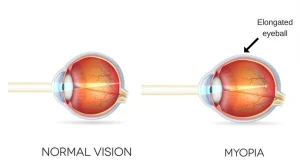WHAT IS HIGH MYOPIA?
The degree or severity of myopia is usually measured as negative by opticians, for example, mild myopia is measured at between -0.25 to -3.00 dioptres (D).
High myopia is categorised as any level measuring greater than -6.00 D. People with high myopia can be at risk from other complications related to eye health, such as cataracts, glaucoma or retinal detachment.
What are dioptres? Dioptres are the units of measurement used when describing the level of impairment. If you wear prescription lenses, the correction required in measured in dioptres with negative (-) meaning you’re shortsighted and positive (+) meaning you have longsightedness.
IS THERE A CURE FOR MYOPIA?
There is no definitive way to permanently end shortsightedness just yet. However, prescription glasses, contact lenses and eye surgery are effective measures for improving eyesight. Regular eye check-ups with an optometrist will help monitor myopic cases and ensure optimal eye health. Links have also been made between spending time outdoors, especially in the sun, and a positive effect on eyesight. Parents are also advised to limit the time children spend in front of computers or on digital devices like mobile phones and tablets as overuse can cause eyestrain.
LIVING WITH MYOPIA
Being shortsighted can make it difficult to function effectively, because of your impaired vision. It can also be uncomfortable for many people, who suffer from eyestrain and headaches as a direct side effect of myopia. The most common and effective way to manage the condition in children is to use prescription lenses such as Myopilux. It corrects far vision and reduces strain for near vision, which differs from the usual single vision lenses that only correct the vision, but do not help with eye strain. This allows you to enjoy perfect and comfortable vision, as well as ensuring the condition does not worsen.
AGE AND MYOPIA: KIDS VS ADULTS
Myopia usually shows between the ages of eight and 12. Complaints of headaches, inability to focus and difficulty seeing things on the whiteboard in the classroom are all signs of shortsightedness in children. If manifested in infancy, parents should look for signs such as squinting and rubbing of the eyes. Parents should have their child’s eyes checked at regular intervals to test for myopia. Early treatment of myopia in children may lead to a control of the condition early on in life, so the eyesight doesn’t worsen. Therefore, you should conduct checks on your child’s eyes regularly:
- The first checkup should be done during the first year of their life.
- The next should be at three and a half.
- The third at five years old
After the age of five, regular health checkups and annual screenings should be sufficient to catch it early. Myopia in children can escalate quickly as their bodies and eyes grow. The growth of the eye might stretch the cornea and retina faster. However, children with myopia usually achieve steady vision in their teens. In adults, the deterioration of vision might also have hidden causes such as diabetes or cataracts.

Above content originates from Essilor.



